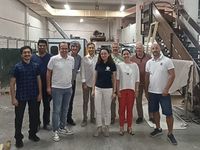ZERAF is a disruptive façade concept (ZERo-carbon building enabler Adaptive opaque Facade), which aims to contribute to the necessary drastic reduction of the carbon footprint of the building stock in the EU.Om to achieve a strong reduction in the energy demand for heating and cooling of buildings, the ZERAF concept shifts the opaque building façade systems from static thermal barriers to thermal modulators. Disruptive configurations of opaque façade technology and the use of innovative materials (smart Shape Memory Alloys and new generation of bio-based polyurethanes) enable such dynamic thermal control. In addition, ZERAF minimizes the number of primary sources (in terms of volume and diversity) and subsequently of the embodied carbon. ZERAF radically reconceptualizes the concept of adaptive opaque façades and takes the opportunity to conduct high-risk, low-TRL research in an interdisciplinary environment to bring cutting-edge novelties from aerospace, biomedicine, nanomaterials, chemistry and IOT to the construction industry. The aim of the EIC-EU funded project is to scientifically prove that the ZERAF concept can control all heat transfer mechanisms in opaque building facades to a significant level. Prototypes will be produced for the first time and their thermal behavior will be characterized in a special laboratory. To demonstrate that materials used, manufacturing processes and assembly methods do not compromise the reduction of the carbon footprint, most of the relevant sustainability parameters will be quantified through a building life cycle methodology.
The team
see for further information: https://zeraf-technology.eu/
Technical meeting of zeraf project at the pilot plan of INDRESMAT
On August 31 and September 1, 2023, we celebrated a technical meeting of the ZERAF project at the INDRESMAT pilot plant. INDRESMAT is our project partner that conducts pioneering research in the field of chemistry and is working hard to successfully bring our innovative ZERAF façade solution into the construction industry. The meeting took place in Barcelona, where all project partners discussed design aspects at an early stage and needed future steps for technological development.
The team in Barcelona visiting Indresmat
Evaluation of Zeraf objectives after 1 year. February 2024
ZERAF (ZERo-carbon building enabler Adaptive opaque Facade) is a new façade concept that aims to reduce the carbon footprint of buildings in the EU. Using innovative materials and dynamic thermal control systems, ZERAF transforms opaque building facades from static thermal barriers to thermal modulators. It does this by bringing together cutting-edge technologies from different fields, such as aerospace, biomedicine, nanomaterials, chemistry, and IoT, to reconceptualize the adaptive opaque façade concept. It involves high-risk/low-TRL research in an interdisciplinary environment to bring innovative solutions to the construction industry. The expected impact of the developed innovative technology is the sharp reduction of the energy demand of buildings for heating and cooling, while minimizing the number of primary sources and embodied carbon. This will have a major impact on the environment and on the European economy and society, in terms of (i) reducing the operational energy consumption of buildings, thereby reducing electricity bills and reducing dependence on petrol and gas; (ii) minimising the carbon footprint of both new and existing buildings, thereby mitigating climate change; (iii) generating new products for the construction sector that create new jobs, stakeholders and innovative and sustainable European industrial lines, and (iv) creating NEB-compliant architectural styles. ZERAF technology can be applied to any building (new or existing) with a significant part of the opaque façade, thanks to the modularity and adaptability of the technology to diverse contexts. ZERAF will also bring a completely new aesthetic to the cities, offering a wide range of design options: kinetic cladding can have endless geometric patterns, and designers will have the freedom to use different materials, coatings, and colors. These aspects are in line with the New European Bauhaus initiative, which aims to propose and build a sustainable and inclusive future that is beautiful (beautiful places, practices and experiences). This future must be enriching, inspired by art and culture, and meet needs that go beyond functionality; sustainable, in harmony with nature, the environment and our planet and inclusive. The versatility of the technology will make it possible to apply its adaptation in different climatic areas, ensuring a just energy transition for all. In terms of the creation of new products, the envisaged technology will entail new formulations of polyurethane and smart metals that will boost the production and industry of advanced materials in Europe. This will open up new industry lines compatible with new industrial processes for bioPUR and SMA building actuators, creating jobs in the chemical and materials science sectors. In addition, it is expected that different materials will be suitable for the developed technology depending on the different climates, the use of buildings, and the availability of materials in the geographical area. This creates a large and diversified market in Europe. New markets and jobs will be created, thanks in part to the new dynamic characteristics of opaque façade technologies. Managing ZERAF requires interdisciplinary expertise in automation, thermodynamics, and building physics, which will create new business models capable of leveraging the co-benefits of ZERAF technology. This will create new businesses and jobs. The aim of the EIC-EU funded project is to scientifically prove that the ZERAF concept can significantly control all heat transfer mechanisms in opaque building facades. For the first time, prototypes will be produced and their thermal behavior will be characterized in a special laboratory. This characterization will enable the validation of advanced simulation models at building and component scale. To demonstrate that the materials, production processes and assembly methods used do not compromise the reduction of the carbon footprint, the key sustainability parameters will be quantified using a building life cycle assessment. Work carried out and main achievements The focus of the first year of the project was on the conceptual definition of the ZERo-carbon building that enables Adaptive Opaque Facade (ZERAF). Two main concepts were developed: one for new buildings and one for the energy-efficient adaptation of existing façades. Possible materials, geometries and configurations of ZERAF technology concepts were mapped. This process was supported by a life-cycle and preliminary cost analysis, to understand the environmental and cost implications of the identified options. The technology concepts were then evaluated with preliminary simulations at building and component level. According to the results, several designed variations of the technology can significantly control the heat exchange between the indoor and outdoor environment. Based on the non-validated simulation results and the identified best performing design options, prototypes of the technology will be manufactured. In fact, the first components of ZERAF are already being prototyped, such as a shape-memory alloy actuator and several new bio-polyurethane samples with different densities and recycled polyurethane content. To date, it has been possible to achieve 10% recycled content in the bio-polyurethane formulation without compromising the quality and stability of the foam. In addition, the thermal performance of these bio-polyurethane samples has been tested and found to be comparable to conventional polyurethane. Results that go beyond the state of the art The opaque building facades available on the market are completely static, while the research world is still struggling to find an effective and reliable adaptive opaque façade concept. Some of these concepts are patented, but not commercialized. Existing adaptive opaque façade concepts are either solely focused on developing a technology to achieve adaptive control of heat transfer, ignoring the other façade requirements, or they have taken the state-of-the-art design approach to ensure that all façade requirements are met. However, the addition of a new requirement (adaptive heat transfer control) would be untenable from the outset if a common multi-layer approach were followed, as it would require additional components to operate (actuators, sensors, wiring and data post-processing elements). Until now, the positive effect of simultaneously modulating and controlling the three types of heat transfer (radiation, convection and conduction) in the opaque part of façades has only been estimated using theoretical data and non-validated calculations. The ZERAF project is a breakthrough, as it will be the first to build, test and characterize this type of opaque façade system. Such a scientific-technological breakthrough will be a major step forward for science, allowing further studies based on reliable data. It will also answer the question of the extent to which this new technology concept eliminates the need for heating and cooling systems in certain buildings and climates. The innovative technology will radically reconceptualize adaptive opaque façades, moving from the current multi-layer façade approach to a façade system that aims for the smallest possible number of materials thanks to the integration of two materials with a low TRL wrench and associated manufacturing processes: the biopolyurethane and Shape Memory Alloy-based actuators.
.png/picture-200?_=18718129238)
.png/picture-200?_=187184f693b)

